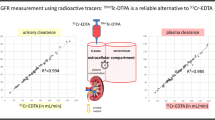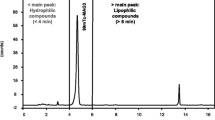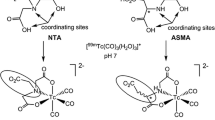Abstract
The aim of this paper was to determine the reproducibility (precision) of technetium-99m mercaptoacetyltriglycine (MAG3) clearance and to compare it with that of chromium-51 ethylenediamine tetra-acetic acid (EDTA). Twelve young volunteers (aged between 21 and 34 years), without any history of medical problems, were enrolled in this study. The test was performed twice, at an interval of 8 days and under similar physiological conditions. After the intravenous injection of both tracers, 15 blood samples were taken between 3 and 240 min. A biexponential fit was adapted to the plasma disappearance curves (5- to 120-min samples for99mTc-MAG3 and 10- to 240-min samples for51Cr-EDTA); the clearances were calculated according to Sapirstein and corrected for body surface area. The mean clearance values were 110 (range 85–130) and 226 (range 109–319) ml/min/1.73 m2, respectively, for51Cr-EDTA and99mTc-MAG3. For51Cr-EDTA clearance, the mean difference between the first and the second measurement was −2.1% of the mean of the two successive values (SD: 8.4%). In ten cases, the difference was less than 12%; in two cases, the differences were 15% and 18%, respectively. For99mTc-MAG3 clearance, the mean difference between the first and the second measurement was −20% of the mean of the two successive values (SD: 25%). In six cases, the difference was less than 12%; in four cases, between 15% and 40%; and in two cases, more than 60%. Methodological factors (impurites contained in the commercial kit, variable protein binding) as well as physiological factors (pH of urine, sodium load, stress) may explain the lack of precision of the99mTc-MAG3 clearance. It is concluded that changes in99mTc-MAG3 plasma clearance should be interpreted with care in daily routine.
Similar content being viewed by others
References
Russell CD, Dubovsky EV. Quantitation of renal function using MAG3 [editorial].J Nucl Med 1991; 32: 2061–2063.
Eshima D, Taylor A Jr. Technetium-99m mercaptoacetyltriglycine: update on the new99mTc renal tubular function agent.Semin Nucl Med 1992; 22: 61–73.
Russell CD, Dubovsky EV. Measurement of renal function with radionuclides.J Nucl Med 1989; 30: 2053–2057.
Taylor A Jr, Corrigan P, Eshima D, Folks R. Prospective validation of a single-sample technique to determine technetium-99m MAG3 clearance.J Nucl Med 1992; 33: 1620–1622.
Piepsz A, Gordon I, Hahn K, Kolinska J, Kotzerke J, Sixt R. Determination of the technetium-99m mercaptoacetyltriglycine plasma clearance in children by means of a single blood sample: a multicentric study.Eur J Nucl Med 1993; 20: 244–248.
Bubeck B. Renal clearance determination with one blood sample: improved accuracy and universal applicability by a new calculation principle.Semin Nucl Med 1993; 23: 73–86.
Bland JM, Altman DG. Statistical methods for assessing agreement between two methods of clinical measurement.Lancet 1986; II: 307–310.
Bröchner-Mortensen J, Rödbro P. Selection of routine method for determination of glomerular filtration rate in adult patients.Scand J Lab Invest 1976; 36: 35–43.
Bröchner-Mortensen J, Rohbrandt K, Lauritzen RB. Precision of single injection51Cr EDTA plasma clearance and endogenous creatinine clearance determinations in children.Scand J Clin Lab Invest 1977; 37: 625–629.
Donath A. The simultaneous determination in children of glomerular filtration rate and effective renal plasma flow by the single injection clearance technique.Acta Paediatr Scand 1971; 60: 512–520.
Brauner J, Westling H. On the necessity of strict bed rest during determination of51Cr EDTA clearance.Clin Physiol 1981; 1: 175–180.
Florijn KW, Barendregt JNM, Lentjes EGWM, etal. Glomerular filtration rate measurement by “single-shot” injection of inulin.Kidney Int 1994; 46: 252–259.
Klingensmith WC III, Briggs DE, Smith WI. Technetium-99m-MAG3 renal studies: normal range and reproducibility of physiologic parameters as a function of age and sex.J Nucl Med 1994; 35: 1612–1617.
Early LE, Friedler RM. Changes in renal blood flow and possibly the intrarenal distribution of blood during the natriuresis accompanying saline loading in the dog.J Clin Invest 1965; 44: 929–941.
Cohen JL, Randall EW. Alkalosis and renalp-aminohippurate transport in dog: relation to lactate uptake.Am J Physiol 1964; 206: 383–390.
Grady HC, Bullivant EM. Renal blood flow varies during normal activity in conscious unrestrained rats.Am J Physiol 1992; 262:R926-R932.
Smith HW. Physiology of the renal circulation.Harvey Lect 1939; 35: 166–169.
Pfeiffer JB Jr, Wolff HG, Winter OS. Studies in renal circulation during periods of life stress and accompanying emotional reactions in subjects with and without essential hypertension; observations on the role of neural activity in regulation of renal blood flow.J Clin Invest 1950; 29: 1227–1242.
Author information
Authors and Affiliations
Rights and permissions
About this article
Cite this article
Piepsz, A., Tondeur, M., Kinthaert, J. et al. Reproducibility of technetium-99m mercaptoacetyltriglycine clearance. Eur J Nucl Med 23, 195–198 (1996). https://doi.org/10.1007/BF01731844
Received:
Revised:
Issue Date:
DOI: https://doi.org/10.1007/BF01731844




